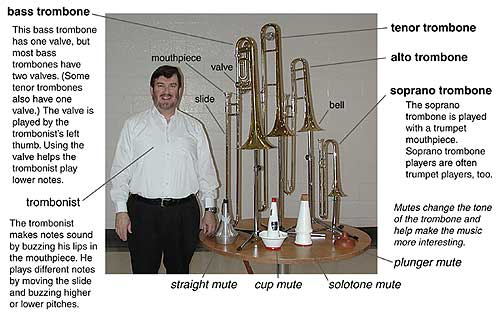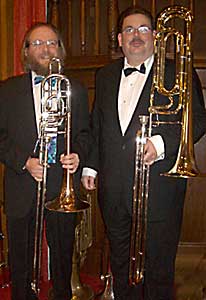
This annotated picture is part of the material Glen Newton used for a trombone family demonstration at the Tesseract school in Eagan, Minnesota, April 2, 2003.
Hear solos by bass, tenor, alto, and soprano trombones on "Brown Wore Black".
 |
This annotated picture is part of the material Glen Newton used for a trombone family demonstration at the Tesseract school in Eagan, Minnesota, April 2, 2003. Hear solos by bass, tenor, alto, and soprano trombones on "Brown Wore Black". |
The four most common members of the slide trombone family have the same names as the members of a vocal quartet: soprano, alto, tenor, and bass.
| The tenor trombone is by far the most popular. It's the one people refer to when they just say "trombone". Its fundamental pitch, the same as that of the euphonium, is an octave below the trumpet or cornet. However, unlike those instruments, the trombone uses a slide to help change pitches. The slides visible in the picture above are the outer slides; each outer slide surrounds an inner slide so that when the trombonist extends the outer slide, the instrument's length increases to allow the trombonist to play a different set of notes. | But what about the valve trombone? |
| This description of the tenor trombone refers to the slide trombone. Much of it (but not the part about moving the slide to change pitches) also applies to the valve trombone. In the United States, the valve trombone is primarily used as a convenient doubling instrument for euphonium or trumpet players, enabling them to play trombone music without mastering slide technique. |
Concert band music and jazz band music for the tenor trombone is written in bass clef, notated in concert pitch. (For example, if you play the trombone parts on a piano, the pitches will be the same.) Orchestral and solo music for the tenor trombone, as well as trombone choir music, is written in a combination of bass and tenor clefs. British brass band music includes two tenor trombone parts, and they are written in treble clef, notated a ninth above the actual sound.
The bass trombone is the next most popular member of the trombone family. Senior high school and college bands and orchestras often include a bass trombone. Over the years, the bass trombone has evolved from an instrument pitched in G, F, or E-flat (a musical third, fourth, or fifth below the tenor trombone) to the modern bass trombone, which is a large-bore tenor trombone with one or two valves to enable the player to reach the lower notes. The historical bass trombone either had a double slide or a single slide that was so long that it required the player to use an extension device to reach 6th and 7th positions.
The term "bore size" refers to the inner diameter of the inner slide. Bass trombones typically have a bore size of 0.560" or larger and a bell size of 9 to 10.5 inches, both of which help the player produce low notes without sounding tinny. Interestingly, the bass trombone in G historically had a much smaller bore and a bell smaller than that of some modern tenor trombones.
Several factors influence the tone of a brass instrument, among them the shape of the bore (the inside of the tubing from the mouthpiece to the bell). The tenor trombone, bass trombone, and euphonium all have the same fundamental pitch when no valves or slide are used, and the trombones will sound very much alike because their bores are similar in shape, with a large portion being cylindrical (a tube that is the same size throughout), even though the bass trombone bore size is larger. In contrast, the euphonium sounds different - some say "deeper" or "mellower" or "less edgy" - primarily because a greater percentage of its bore is conical (a gently expanding tube shape).
Bass trombone parts are always written in bass clef in concert pitch.
Tenor and bass trombones are manufactured with several different valve configurations:
Tenor trombone with no valve (shown in the picture above) - generally small (e.g., 0.490") to medium (e.g., 0.542) bore
Tenor trombone with one valve - generally medium bore (e.g., 0.525" to 0.542"); pressing the valve with the left-hand thumb increases the length of the air column and thus lowers the pitch a perfect fourth. If you hear someone refer to a "trigger trombone", this is what he means; the valve is also known as a trigger. Some manufacturers offer a convertible tenor trombone, from which the valve section may be removed to lighten the instrument when the valve isn't needed.
Bass trombone with one valve (shown in the picture above); the valve has the same function as on the tenor trombone, but the bass trombone player will sometimes extend the tuning slide of the valve section so that pressing the valve will lower the pitch an extra half step or more beyond the perfect fourth. This helps the bass trombonist with only one valve play a solid low C and minimizes the amount of "lipping down" that he or she must do to reach a low B below the bass staff.
Bass trombones with two valves, the second "dependent" on the first. The first valve, played with the thumb, lowers the pitch a perfect fourth. The second valve may be controlled with another thumb lever or with a lever for the left hand index finger. Pressing them both together will typically lower the pitch a perfect fifth or minor sixth, depending on how far out the player pulls the tuning slide for the second valve section, but other configurations are available. With two valves, a solid low B is within easy reach, so there is no need for the player to extend the first valve's tuning slide.
Bass trombones with two "independent" valves (shown in the picture below). As in the "dependent" case, the first valve will lower the pitch a perfect fourth. The second valve, typically played by the left hand index finger, can be used even if the first valve isn't, hence the two valves are independent of one another. Bass trombonists often tune the second valve section so that pressing the valve alone lowers the pitch a major third. Then when both valves are used together, the pitch is lowered by a minor sixth. Other popular second valve tunings lower the pitch by a minor third and a minor sixth.
The valves on a slide trombone are rotary valves. In contrast, the valves on a tenor valve trombone are piston valves. One special model, the Superbone by Holton, has both a slide section and a valve section; the player's right hand manipulates the slide, and the left hand plays the valves. Maynard Ferguson was the first great artist to play the Superbone.
Typical jazz charts, such as those played by the Roseville Big Band, have four trombone parts. The first three are always tenor trombone parts written for instruments without a valve section, and the fourth is most often written for bass trombone, with some alternate notes that don't require a valve section in case the player doesn't have the equipment for the low notes.
Tenor and bass trombone mouthpieces are manufactured with two different shank sizes. Tenor trombones with a small or medium bore use a tenor trombone shank, the smaller of the two. Bass trombones and large-bore tenor trombones use mouthpieces with a bass trombone shank, which is larger and aids in the production of a full sound on medium and low notes. Within each shank size, there is a nearly limitless variety of cup depths, backbores, rims, and outer shapes to suit the player's needs and tastes. In general, players who need to reach very high notes will choose a mouthpiece with a shallow cup and small rim diameter; the opposite is true of those who must play very low notes.
The modern alto trombone is pitched a perfect fourth higher than the tenor trombone. It has very limited use, compared with the tenor and bass trombone, but it is used in the orchestra, where many composers, particularly Beethoven and his contemporaries, created the first trombone parts to be played on the alto trombone. The alto trombone also has a role in the Moravian trombone choir (where its traditional pitch is F more often than E-flat) and in the modern trombone choir. In addition, there is a large solo repertoire for alto trombone. To help alto trombone players cope with the solo literature (and cover both alto and tenor trombone parts without having to carry a second instrument), some makers offer an alto trombone with a valve section in which pressing the valve lowers the pitch a perfect fourth.
The alto trombone mouthpiece shank is the same as that of the tenor trombone. Players who double on alto and tenor trombones (which is virtually 100% of all alto trombone players) often choose alto and tenor trombone mouthpieces with matching rims but differing cups and backbores.
The soprano trombone is pitched an octave above the tenor trombone. Its uses are even more limited than those of the alto trombone, principally confined to the trombone choir.
The soprano trombone is played with a trumpet mouthpiece. Because adapting to the mouthpiece is a significant part of learning to be a brass player, a significant percentage of the soprano trombone players in trombone choirs are trumpeters who have learned to deal with the slide, rather than trombonists who have learned to cope with the smaller mouthpiece. Furthermore, music for soprano trombone is usually notated the same as trumpet music, in treble clef, written one whole step above its sounding pitch. This has a practical value for composers who write for trombone choir, because if no soprano trombonist can be found, the part can be played on trumpet without requiring any transposition.
The sopranino and piccolo trombones are also played with trumpet mouthpieces. Like the higher trumpets, they appear in a variety of keys. For example, the ten-piece brass ensemble German Brass occasionally uses a sopranino trombone in D, a major third higher than the soprano trombone, although the sopranino trombone in E-flat (a half step higher) is somewhat less rare; they also use a piccolo trumpet in B-flat, an octave above the soprano trombone. (You can see a comparison on the Thein Brothers web site, which displays a full range of trombones, from sopranino to contrabass.)
 |
Like the bass trombone, the contrabass trombone has had a variety of pitches and configurations throughout its history, reflecting the efforts of the players and makers to achieve a reasonable compromise between tone and convenience. The contrabass trombone is called for in some trombone choir and orchestral music, such as the operas of Wagner, and depending on the demands of the music (and equipment availability), the performer will typically use either a large-bore trombone in F with two valves or an instrument pitched an octave below the tenor trombone, in BB-flat, having a double slide. Alternatively, especially in the orchestra pit where space is at a premium, the player may use a valve contrabass trombone in a vertical configuration, in which the lower part of the instrument rests on the floor. Contrabass trombones have also been made in E-flat and CC. In this picture, Ken Leginchin, at the right, holds his Mirafone BB-flat single-rotor contrabass trombone and Don Dresser, at the left, holds his Olds double-rotor bass trombone. This contrabass trombone has a mouthpiece receiver that fits a tuba mouthpiece, and the mouthpiece pictured was made for a small tuba. |